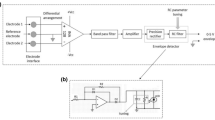Abstract
This paper was aimed at determining a way to create an EMG signal in muscle tissue, and identify factors that affect this signal. We also studied the methods for recording and filtering this signal in order to control a prosthetic limb such as a hand. A new method is discussed for controlling a prosthetic limb capable of interacting with brain and the nervous system. In this system, which is called IMES (Implantable Myoelectric Sensor), EMG signals were recorded using a series of Implantable Myoelectric Sensors. These signals were then transmitted to a telemetry controller for analysis using a wireless system. The system developed here allows the acquired data to be sent to a prosthetic limb controller and move the prosthetic limb toward patient's desired directions without wiring or a surgical procedure to implant the controller under the skin. It is also possible to monitor the data from EMG signals via a USB port or an external computer connected to the IMES system. Our results indicate that we can record the EMG signals without noise via implantable myoelectricsensors and telemetry controller in an IMES system. This allows to control a prosthetic hand based on the brain and nervous system's commands.

ᅟ












Similar content being viewed by others
Change history
20 December 2017
In the version of this article initially published, the affiliations of the authors were incorrectly written. The correct presentation is indicated in this paper.
References
C Freudenrich. How biomechatronics works. University of MIT; 2007.
Zecca M, Micera S, Carrozza MC, Dario P. Control of multifunctionalprosthetic hands by processingtheelectromyographic signal. ARTS Lab, ScuolaSuperioreSant’Anna, Pontedera, Italy; 2002.
Electronic Publication: www.bleng.com.
Ferris DP, Sawicki GS, Domingo AR. Powered lower limb orthoses for gait rehabilitation. University of Michigan; 2005.
Ajiboye AB, Weir RF. A heuristic fuzzy logic approach to EMG pattern recognition for multifunctional prosthesis control. IEEE Trans Neural Syst Rehabil Eng. 2005;13(3).
Lowery MM, Weir RF, Kuiken TA. Simulation of intramuscular EMG signals detected using Implantable Myoelectric Sensors (IMES). IEEE Trans Biomed Eng. 2006;53(10).
Chowdhury RH, Reaz MBI, Ali MABM, Bakar AAA, Chellappan K, Chang TG. Surface electromyography signal processing andclassification techniques. Department of Electrical, Electronic and Systems Engineering, UniversitiKebangsaan Malaysia, Bangi, Selangor 43600, Malaysia; 2013.
Arieta AH, Katoh R, Yokoi H, Wenwei Y. Development of a multi-DOF electromyography prosthetic system using the adaptive joint mechanism. Hongo: Laboratory of Bioinstrumentation and Biomechatronics, University of Chiba; 2006.
Dellon B, Matsouka Y. Prosthetics, exoskeletons, and rehabilitation. IEEE Robot Autom. 2007
Atzori M, Müller H. Control capabilities of myoelectric robotic prostheses by hand amputees: a scientific research and market overview. Information Systems Institute, University of Applied Sciences Western Switzerland, Sierre, Switzerland; 2015.
Rajangam S, Tseng P, Yin A, Lehew G, Schwarz D, Lebedev MA, et al. Wireless cortical brain-machine interface for whole-body navigation in primates. Duke University Medical Center, Durham, NC; 2016.
ParadaPuig JE, Rodriguez NEN, Ceccarelli M. A methodology for the design of robotic hands with multiple fingers, University of Los Andes, Faculty of Engineering, School of Mechanical Engineering. Int J Adv Robot Syst. 2008;5(2).
Moulianitis VC, Syrimpeis VN, Kokkinos V, Aspragathos NA, Panagiotopoulos EC. A closed-loop drop-foot correction system with gait event detection using fuzzy logic. Mechanical Engineering and Aeronautics Dept. University of Patras Greece; 2008.
Sensinger JW, Weir RF. User-modulated impedance control of a prosthetic elbow in unconstrained, perturbed motion. IEEE Trans Biomed Eng. 2008;55(3).
Ciancio AL, Cordella F, Barone R, Antonio Romeo R, Bellingegni AD, Sacchetti R, et al. Control of prosthetic hands via the peripheral nervous system. Unit of Biomedical Robotics and Biomicrosystems, Department of Engineering, Università Campus Bio-Medico di Roma, Roma, Italy; 2016.
Acknowledgments
We thank Dr. N. Sheibani with the preparation and editing of the manuscript.
Author information
Authors and Affiliations
Corresponding author
Ethics declarations
Conflict of interest
The authors declare that they have no conflict of interest.
Additional information
All human subjects were healthy adults and agreed to the parameters of this study by signing a consent form based on the Helsinki guidelines and approved by the Institutional Review Board of Science and Research Branch-Islamic Azad University (SRBIAU).
Six able bodied subjects (mean age between 20 and 50) including three males and three females were enrolled in this study. In the first step we evaluated patients such as observation of skin condition, tissue condition, muscle strength and rang of motion an amputee limb. After this step, we recorded EMG signal via surface electrodes. Also, we utilize Otto Bock6 13E200 sensors to record EMG signals because this sensor is used simply as an electrode. Otto Bock’s 13E200 electrodes use a 100–400 Hz band pass filter and a 60 Hz notch filter.
A correction to this article is available online at https://doi.org/10.1007/s12553-017-0213-3.
Rights and permissions
About this article
Cite this article
Sheibani, A., Pourmina, M.A. Study and analysis of EMG signal and its application in controlling the movement of a prosthetic limb. Health Technol. 6, 277–284 (2016). https://doi.org/10.1007/s12553-016-0142-6
Received:
Accepted:
Published:
Issue Date:
DOI: https://doi.org/10.1007/s12553-016-0142-6




